
Abstract
Holographic displays can generate light fields by dynamically modulating the wavefront of a coherent beam of light using a spatial light modulator, promising rich virtual and augmented reality applications. However, the limited spatial resolution of existing dynamic spatial light modulators imposes a tight bound on the diffraction angle. As a result, modern holographic displays possess low étendue, which is the product of the display area and the maximum solid angle of diffracted light. The low étendue forces a sacrifice of either the field-of-view (FOV) or the display size. In this work, we lift this limitation by presenting neural étendue expanders. This new breed of optical elements, which is learned from a natural image dataset, enables higher diffraction angles for ultra-wide FOV while maintaining both a compact form factor and the fidelity of displayed contents to human viewers. With neural étendue expanders, we experimentally achieve 64× étendue expansion of natural images in full color, expanding the FOV by an order of magnitude horizontally and vertically, with high-fidelity reconstruction quality (measured in PSNR) over 29 dB on retinal-resolution images.
Citation
@article{tseng2024neural,
title={Neural {\'e}tendue expander for ultra-wide-angle high-fidelity holographic display},
author={Tseng, Ethan and Kuo, Grace and Baek, Seung-Hwan and Matsuda, Nathan and Maimone, Andrew and Schiffers, Florian and Chakravarthula, Praneeth and Fu, Qiang and Heidrich, Wolfgang and Lanman, Douglas and others},
journal={Nature Communications},
volume={15},
number={1},
pages={2907},
year={2024},
publisher={Nature Publishing Group UK London}
}
All images are © Springer Nature, reproduced here by permission of Springer Nature for your personal use. Not for redistribution.